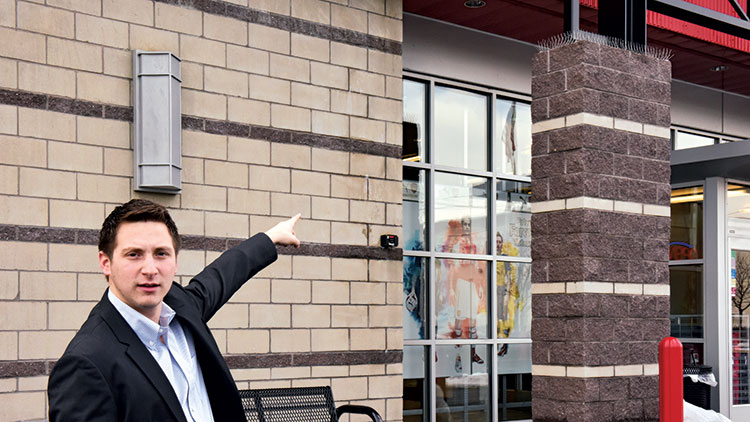While many retail chains and box stores differ in size, location and landscape, they all share one similarity: ideal conditions for pest bird activity.

Look up at the bird deterrents installed atop this store’s support columns.
Photo: ©Fred Miller Photography
Walk into just about any retail store and you’ll find a wide variety of structures — large signs, support beams, parapet ledges and canopies around the exterior — that provide the protective elements necessary for many types of birds. You’ll also often encounter rooftop heating, ventilation and air-conditioning (HVAC) systems or cooling towers that serve as a good source of heat and moisture for pigeons, seagulls, starlings and sparrows. It’s pretty much a given that you’ll discover a rich history of bird activity at the property, which yields high-pressure zones of determined birds unwilling to move from their nest location. Plus, with main entrance or loading dock doors left open in these spaces, birds are able to find areas within the store to live.
Because of the great need these stores experience with various bird issues, tremendous opportunity for bird management exists in the retail arena.
Break it down into steps
The first step of the bird management process is to identify and define the store’s bird problem. The best method is to look up to observe the birds flying around the customer’s building and nesting on signs, and look down to see the bird droppings on the sidewalk. This allows you to move to the next step: scheduling and securing the bird inspection.
Retail stores might have vendor requirements at the regional, or even corporate level, but the best place to start is at the store. Usually, the store manager can guide you toward securing an inspection with the retail chain. Once a formal walkthrough is confirmed on the local level, observe the areas containing live birds, nesting material and bird defecation, with the store manager.
Share your collected evidence with the store manager, and take pictures and measurements of the height, length and width of the entire target or proposed areas. Capture quality pictures of the bird activity. They can be helpful when preparing your proposal, and will allow you to communicate to the regional or corporate facility team the level of bird activity at the retail location.
Finally, write and submit your proposal. Provide the scope of the proposed work and competitive pricing that includes labor, materials, special tools, insurance requirements, and lift equipment as needed.
Three tactics to take
Three treatment techniques dominate the bird management arena:
- Bird exclusion efforts are best installed in such places as over the exterior signage, under the loading dock, and other canopy areas to prevent bird harborage. Proper installation of a variety of exclusion products ensures birds are unable to penetrate the area.
- Bird deterrents are installed on exterior signage, parapet ledges and support beams to mitigate the immediate roosting and nesting population. Again, there are a variety of products from which to choose.
- Bird removal is used when birds are trapped or living inside the structure. Vertical netting and bird traps enable you to release and discharge captured birds after removing them from the property. Bird harvesting, on the other hand, ensures a quick, efficient and euthanized removal in accordance with state and local laws. This last-resort methodology typically is used when all other options have been exhausted.
The next time you’re shopping at your favorite store, look up and look down. It could turn into a great opportunity for you and your business.
Daniel Aust is the director of business development at Bird Doctor Worldwide and Bug Doctor Nationwide. He can be reached at 201-599-1007 or daniel@birddoctorinc.com.
Leave A Comment